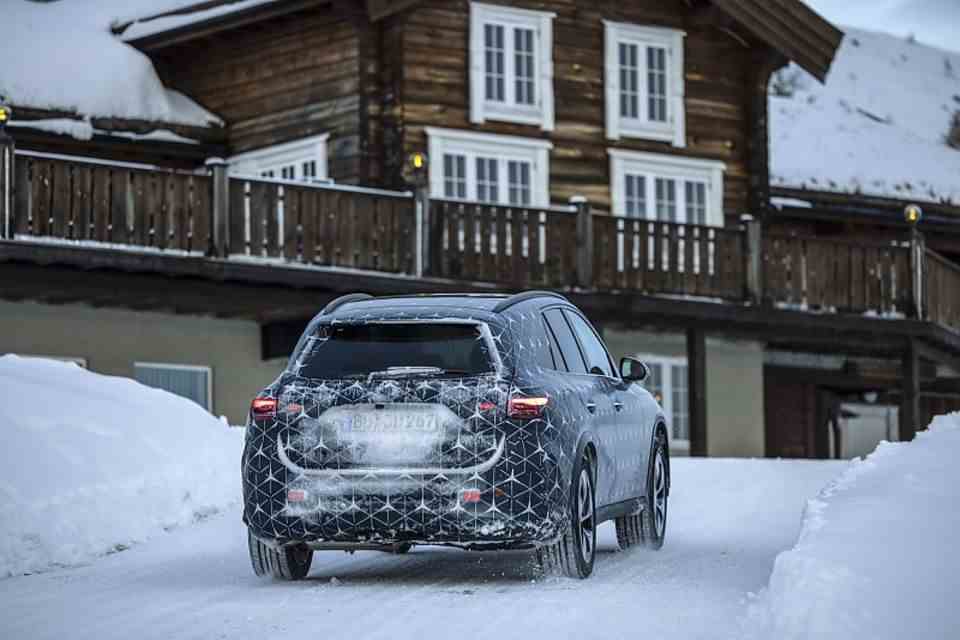Winter testing Mercedes GLC
Quiet and agile
The Mercedes GLC X254 is in winter testing
© press-inform – the press office
With the new GLC, Mercedes relies on a combination of comfort and agility thanks to rear-axle steering. We took part in the winter testing and put the SUV to the test.
Despite all the hype surrounding the electric group, the Mercedes GLC is the best-selling model series from the Swabian car manufacturer. If you add the predecessor GLK, more than 2.5 million drivers worldwide have opted for the mid-size crossover. The next generation will follow in autumn, the internal code X253 will then become X254. It is obvious that such a successful model should not be neglected, so all variants with petrol and diesel engines are electrified with a 17 KW / 23 PS mild hybrid module and the GLC with the well-known plug-in hybrid module should go in travel more than 100 kilometers electrically. With all the technical affinity to the C-Class, the long-legged brother also gets a petrol version with six cylinders, as befits its status. The diesel units only have four pots and the performance spiral ends at 195 kW / 265 hp.
We are now sitting in this top model of the diesel group and getting our first impression of how well the GLC performs on surfaces with a low coefficient of friction on the frozen lake of ice. The SUV acts unspectacularly and in this case that is exactly what the developers want, because a car with the star on the radiator grille should not suddenly cause problems for the driver. The interaction between all-wheel drive and rear axle steering works smoothly. “We have a torque distribution of 45 at the front and 55 at the rear,” explains Peter Kolb, Head of Total Vehicle Testing GLC. And this rear-biased design of the all-wheel drive brings a lot of joy and a lively rear end in such conditions, and so the GLC sometimes flies across the icy corner despite its almost 1.9 tons live weight. “The rear-axle steering brings a lot of dynamics and stability,” says Peter Kolb.
The striking appearance of the new GLC also fits in with this. The bonnet is higher than before and the face is therefore more massive. We switch to the Mercedes GLC 220d 4Matic with 145 kW / 197 hp plus the mentioned 17 kW / 23 hp of the mild hybrid module and at the same time to the passenger seat. A look at the screen bar reveals the close relationship to the C-Class. Matching the higher front, the monitors are also higher. The trunk is now one meter deep (previously 90 centimetres) and has a capacity of 600 liters, 50 liters more than the current GLC. Sounds good. But it is more noticeable how quiet it is in the GLC 220d, especially since the four-cylinder diesel is not a quiet stroller per se. That is insulating glass in front and other noise-insulating measures keep the noise outside. In addition to the engine sound, the rolling noise of the tires and the airflow are also important. So the new GLC should surpass the quiet factor of the predecessor even without the acoustic package.
Our car is also equipped with the optional Driving Package. That means: air springs, adjustable dampers and 4.5-degree rear-axle steering. This means that the SUV can also be used in the city and in narrow parking garages. The steering rear wheels reduce the turning circle by one meter from 11.8 meters to 10.8 meters. When it comes to comfort, the engineers also want to step it up a notch. In addition to comfort, the technicians are also getting more and more efficiency out of the chassis in order to increase the range. With the active dampers, the maxim is now “Normally Open”. This means that the chassis is generally tuned to be softer, thus saving electricity. “We want the car to follow the road but not copy the surface,” says Dominik Voogdt, who calls the handling “floaty”. Sounds easy, but requires a lot of tuning work. Because from comfort to annoying teetering is a very fine line, but the new GLC avoids it quite well. At least that’s the first impression. But the GLC X254 can also be different. In Sport mode, the chassis is noticeably firmer.
The new GLC has a treat in store for off-road fans. As soon as you venture off-road and select the appropriate driving mode, the bonnet disappears, as you are already familiar with from Land Rover. To do this, the Swabians use the camera at the top of the windscreen, the camera in the radiator grille and the cameras in the exterior mirrors. From these individual images, the system puts together a virtual image as a “view under the front of the vehicle” in which the bonnet appears transparent. However, this is only the case at low speeds, if you go faster, the graphics on the central 11.9-inch infotainment monitor change and resemble those of a jet with an artificial horizon and measuring units on both edges.


